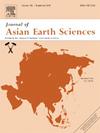Origin of Pb–Zn deposits in the Hengyang Basin in the central part of the Qin-Hang metallogenic belt (South China): An example from the Yantianqiao deposit
IF 2.4
3区 地球科学
Q2 GEOSCIENCES, MULTIDISCIPLINARY
引用次数: 0
Abstract
The metallogenesis of hydrothermal vein-type Pb–Zn deposits in the Hengyang Basin, part of the central Qin-Hang Metallogenic Belt (QHMB, South China), remains debate, with magmatic-hydrothermal and MVT models proposed. Yantianqiao (33903 t @ 3.25 % Pb and 1542 t @ 2.62 % Zn) is a representative deposit, features four distinct mineralization stages: (I) quartz-pyrite, (II) quartz-pyrite-chalcopyrite, (III) main-ore quartz-galena-sphalerite, and (IV) quartz-calcite. The limited pyrite δ34S range (−5.8 to −1.7 ‰), similar 207Pb/206Pb ratios between galena (0.8483–0.8488) and the Zhaobingshan granodiorite (corrected average 0.86), and sphalerite geochemistry (Fe-In-enriched, Ga-Ge-depleted), reveal a genetic link between mineralization and the granodiorite. The low Co/Ni ratios (average 2.01) and δ34SV-CDT values (−4.0 ‰) of Stage I pyrite, commonly trapping silicate inclusions, indicate the marked fluid-rock interaction. The high Se/Te ratios (14.3) and As concentrations (median: 249 ppm), but depleted Co-Ni, of Stage II pyrite (Py-II) suggest minor meteoric fluid influx during this stage, also evidenced by the reported quartz H–O isotopes. Furthermore, low-fS2 condition (−10.5 to −12.4) and Mn-depletion (0.869 ppm) of Stage III sphalerite (Sp-III) reflect the waning magmatism and increased meteoric fluid influx during Stage III, consistent with its low formation temperature revealed by Ni-Se-Bi-Mo depletion and SPRFT geothermometer result (119 ± 29 °C) of Sp-III. Therefore, Yantianqiao is inferred to be a magmatic-hydrothermal deposit genetically related to the Zhaobingshan granodiorite, with Pb–Zn mineralization driven by a progressively increasing meteoric fluid influx. This study advances the understanding of Pb–Zn ore genesis in the Hengyang Basin and provides insights applicable to similar sedimentary basins worldwide.
秦航成矿带中段衡阳盆地铅锌矿床成因——以盐天桥矿床为例
作为秦航成矿带中部的一部分,衡阳盆地热液脉状铅锌矿床的成矿作用仍存在争议,提出了岩浆-热液和MVT两种成矿模式。盐田桥(33903 t @ 3.25% Pb, 1542 t @ 2.62% Zn)为代表性矿床,具有4个明显的成矿阶段:(I)石英-黄铁矿,(II)石英-黄铁矿-黄铜矿,(III)主矿石英-方铅矿-闪锌矿,(IV)石英-方解石。有限的黄铁矿δ34S范围(−5.8 ~−1.7‰),方铅矿(0.8483 ~ 0.8488)与兆冰山花岗闪长岩(校正平均0.86)的207Pb/206Pb比值相近,闪锌矿地球化学特征(富fe - in,贫ga - ge)表明成矿作用与花岗闪长岩存在成因联系。ⅰ期黄铁矿Co/Ni比值低(平均2.01),δ34SV-CDT值(- 4.0‰),常包裹硅酸盐包裹体,表明其流体-岩石相互作用明显。II期黄铁矿(Py-II)的高Se/Te比值(14.3)和As浓度(中位数:249 ppm),但Co-Ni含量下降,表明该阶段有少量的大气流体流入,石英H-O同位素也证明了这一点。III期闪锌矿(Sp-III)的低fs2状态(−10.5 ~−12.4)和mn损耗(0.869 ppm)反映了III期岩浆活动减弱和大气流体流入增加,与Sp-III的Ni-Se-Bi-Mo损耗和SPRFT地温计结果(119±29°C)显示的低形成温度一致。因此,推断盐田桥是一个与赵炳山花岗闪长岩成因相关的岩浆热液矿床,其铅锌成矿作用受逐渐增加的大气流体流入的驱动。该研究促进了对衡阳盆地铅锌矿成因的认识,并为全球同类沉积盆地提供了借鉴。
本文章由计算机程序翻译,如有差异,请以英文原文为准。
求助全文
约1分钟内获得全文
求助全文
来源期刊

Journal of Asian Earth Sciences
地学-地球科学综合
CiteScore
5.90
自引率
10.00%
发文量
324
审稿时长
71 days
期刊介绍:
Journal of Asian Earth Sciences has an open access mirror journal Journal of Asian Earth Sciences: X, sharing the same aims and scope, editorial team, submission system and rigorous peer review.
The Journal of Asian Earth Sciences is an international interdisciplinary journal devoted to all aspects of research related to the solid Earth Sciences of Asia. The Journal publishes high quality, peer-reviewed scientific papers on the regional geology, tectonics, geochemistry and geophysics of Asia. It will be devoted primarily to research papers but short communications relating to new developments of broad interest, reviews and book reviews will also be included. Papers must have international appeal and should present work of more than local significance.
The scope includes deep processes of the Asian continent and its adjacent oceans; seismology and earthquakes; orogeny, magmatism, metamorphism and volcanism; growth, deformation and destruction of the Asian crust; crust-mantle interaction; evolution of life (early life, biostratigraphy, biogeography and mass-extinction); fluids, fluxes and reservoirs of mineral and energy resources; surface processes (weathering, erosion, transport and deposition of sediments) and resulting geomorphology; and the response of the Earth to global climate change as viewed within the Asian continent and surrounding oceans.
 求助内容:
求助内容: 应助结果提醒方式:
应助结果提醒方式:


